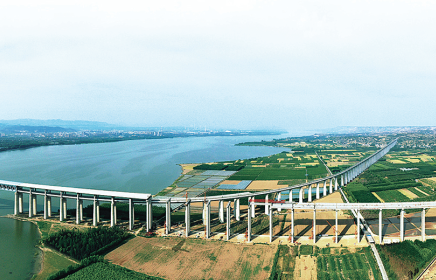Green technology used to build roads linking province's tourist sites
Updated: 2022-09-16

An expressway bridge across the Yellow River links Shanxi with neighboring Henan province. [Photo by Sun Rongxiang for China Daily]
As the weather became cooler in early September, construction workers stepped up the pace in the construction of an expressway that was designed to connect the county of Licheng and the city of Huozhou in Shanxi province.
The expressway, scheduled to be operational in 2024, reached the halfway point of its planned length this month.
"The expressway will link two major tourist attractions-the Taihang Mountains and the Yellow River-in Shanxi province," said Wang Lijie, chairman of Lihuo Expressway Corp, the investor of the expressway.
The executive said the expressway will become another major transport channel to link North China and Northwest China, as it is scheduled to extend to Handan city in Hebei province and Xi'an city in Shaanxi province some two years later.
The expressway is one of the latest steps in the development of Shanxi's booming road network.
According to the Shanxi Department of Transport, a total of 2,000 kilometers of expressways have been added to the province over the past 10 years, bringing its total length to 5,763 km. Construction of highways has also accelerated, with roads now connecting virtually every village in the province.
To boost the local tourism industry, three highways-Taihang No 1, Yellow River No 1 and Great Wall No 1-have been built to connect destinations along the three landmark attractions of the Taihang Mountains, the Yellow River and the Great Wall.
In recent years, Shanxi has increased the use of high and environmentally friendly technologies in the construction of transport projects.
The expressway connecting Licheng and Huozhou, for example, is using assembled structures for building large-span bridges for the first time in Shanxi.
For this innovative construction method, building components have been manufactured in nearby plants and delivered to construction sites for assembly. The construction process can be several times faster than conventional practices featuring casting concrete on the site, according to executives of Lihuo Expressway.
Smart technologies have also been applied in road and railway construction throughout Shanxi. The use of welding robots and automatic tunneling machines is popular on many construction sites, which has substantially improved efficiency and safety, according to the provincial transport department.
Operations of traffic facilities are becoming increasingly intelligent too. For instance, the department has promoted the use of a monitoring and alarming system for vehicles transporting hazardous chemicals throughout the province. Officials said the system can substantially improve safety for drivers by making timely detections of risks and rescuing possible.
To reduce their footprint on the environment, many construction projects have used a variety of environmentally friendly technologies, which include solid waste recycling and reuse; greening construction sites for ecological repair; reducing emissions; and disposing of wastewater on the sites, according to officials at the transport department.
Leng Xue contributed to this story.



